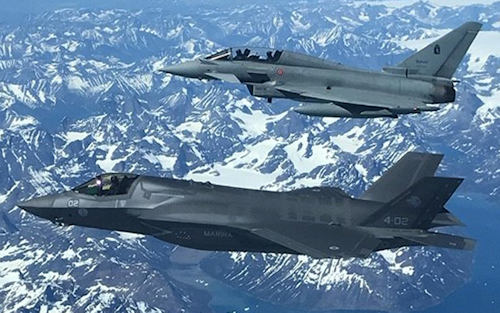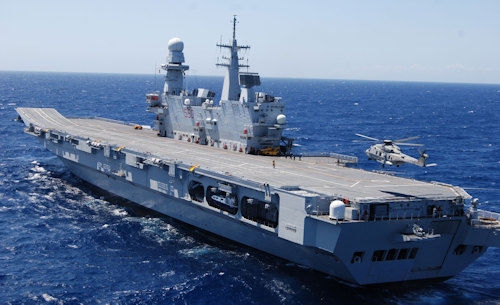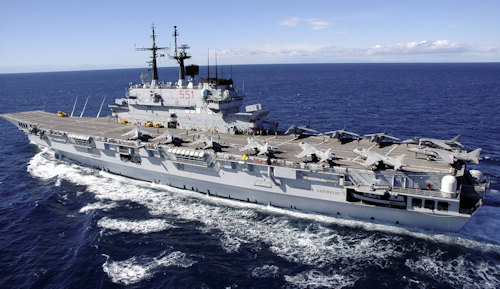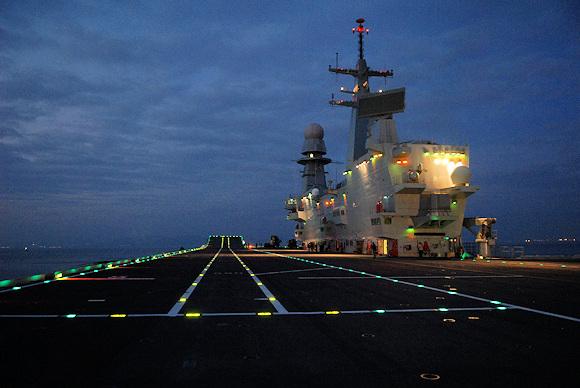The Italian aircraft carrier Cavour is preparing to sail to the United States, with the aim of starting the essential activity for the qualification of the flight deck and of the entire ship "system" for the use of the fifth generation Lockheed Martin F-35B fighter lighting. It is the most advanced fighter aircraft in the world, with short take-off and vertical landing, which unites ("would unite", ndd - v.articolo) to the characteristics stealth (i.e. very low radar visibility) also very high connection capacity between weapon and pilot systems and between aircraft and command and control systems.
The F-35 lightning is built in three versions, the first of which is called "Alfa", the conventional take-off and landing (CTOL1), which operates from the airports. The other two are called "Bravo" and "Charlie" and are naval versions designed to meet precise construction and operational characteristics of the units on which they are to be embarked, that is aircraft carriers or amphibious units with or without ski-jump (version "B" STO / VL2, with short take-off and vertical landing) and aircraft carriers in CATOBAR configuration3, ie equipped with catapults and stop cables (version "C").
In a world in which the geopolitical situation is magmatic and in which the competition to secure marine energy resources (a rivalry that is leading to the territorialization of some maritime areas, such as the Mediterranean) becomes increasingly important to have the availability suitable aeronaval tools capable of guaranteeing strategic and tactical superiority, such as to allow adequate protection of legitimate national interests, wherever necessary, and to increase the country's international prestige.
 Hence the importance of the aircraft carrier (v.articolo), a tool that allows you to operate promptly wherever needed, ensuring the projection of air-naval power without territorial constraints or clearance from foreign authorities, as instead indispensable for the redeployment of units of the Army or Air Force.
Hence the importance of the aircraft carrier (v.articolo), a tool that allows you to operate promptly wherever needed, ensuring the projection of air-naval power without territorial constraints or clearance from foreign authorities, as instead indispensable for the redeployment of units of the Army or Air Force.
However, every military vessel needs to verify compliance with operational requirements before becoming fully operational. The design, in fact, provides engineering answers to the required requirements. These must then be verified to obtain the certification of suitability and be sure that the unit has all the operational and safety requirements to be able to operate effectively on the world's seas.
Basically, before becoming fully operational, each unit is subjected to the verification at sea of the entire ship "system" as a whole and, therefore, the operating procedures, crew training, weapon systems, are examined. sensors, etc….
To the normal checks of all other ships, the aircraft carrier adds further checks, intended to qualify the flight deck for air operations. This is an indispensable step for achieving full operation since during this period, for example, specific operating procedures are checked at sea, the training of the personnel assigned to the flight deck and air traffic control, the limits for the performance of aerial operations, the correctness of safety procedures, the interfaces between aircraft and the platform, the consistency of equipment and structures. All checks that, in essence, want to ensure that the platform is ready to operate.
 This is a very delicate and fundamental step, which must be carried out with the utmost seriousness and by highly qualified personnel with proven experience. Here is the reason why the aircraft carrier Cavour he will leave the Mediterranean to go to the United States. In the short period in which this activity will be carried out, professionals from the US Navy and Marines will alternate on board, test pilots with hundreds of flight hours behind them and in-depth experience of air operations from aircraft carriers who, together with our pilots, will carry out all the possible tests to be able to operate from board, bringing to the limit the operational capabilities of both the aircraft and the naval unit. A period of intense work that will see the flight deck of the Cavour become a very busy self-propelled and self-sufficient airport, and which will allow the ship to return home with the full awareness of being able to operate effectively anywhere, in any scenario and in any weather condition, to safeguard national security, interests and prestige.
This is a very delicate and fundamental step, which must be carried out with the utmost seriousness and by highly qualified personnel with proven experience. Here is the reason why the aircraft carrier Cavour he will leave the Mediterranean to go to the United States. In the short period in which this activity will be carried out, professionals from the US Navy and Marines will alternate on board, test pilots with hundreds of flight hours behind them and in-depth experience of air operations from aircraft carriers who, together with our pilots, will carry out all the possible tests to be able to operate from board, bringing to the limit the operational capabilities of both the aircraft and the naval unit. A period of intense work that will see the flight deck of the Cavour become a very busy self-propelled and self-sufficient airport, and which will allow the ship to return home with the full awareness of being able to operate effectively anywhere, in any scenario and in any weather condition, to safeguard national security, interests and prestige.
But this intense period of training and evaluation will also serve the crew, our engineers and pilots to gain additional experience, siphoned by a US Navy that has a recognized expertise in this type of naval unit.
While waiting for all the planned F-35Bs to be assigned to the Navy (the acquisition of 15 aircraft in total is planned4, of which only two have been delivered so far), the Cavour navigation continues towards full operational capacity, aware of representing, together with its pilots (airplanes and helicopters) and its specialists, a power factor of Italy.

There are few theaters in the world that have not seen flight crews and Navy specialists operate effectively. In Somalia, Lebanon, and even Afghanistan, as well as in the Red Sea and the Atlantic and Pacific Oceans, flight crews were able to refine their training and operational flight experience, based on the various naval units with flight deck aft and, from the early nineties, also the aircraft carrier cruiser Garibaldi (photo) that in the USA, in August 1991, carried out this type of activity in relation to the boarding of the AV-8B Harrier II Plus aircraft, the first fighter aircraft acquired by the Navy. Those aircraft would, shortly thereafter, successfully operate in Somalia, using the Garibaldi as a platform.
Today, that the AV-8Bs are starting towards the end of their operational life and that the assignment of the most modern F-35Bs is in (slow) progress, in order to deploy a fully operational air-naval component it is therefore necessary that the aircraft carrier that you will have to use them to carry out the qualification tests mentioned above.
A medium-sized regional power, with global interests like Italy, dependent on foreign countries for the supply of energy resources and raw materials, 90% of which is transported along maritime communication routes, must be able to protect its own national interests on the sea, ensuring the safety of marine extractive activities and maritime trade.

The time has come to take "... awareness of how much the sea matters to us ..."5 and how economically dependent we are. It would therefore be desirable for the Navy to be assigned the necessary F-35Bs as soon as possible, for the sake of national security and economy, because "... slowing down the development and modernization processes of the Navy's air fleet risks producing direct and negative consequences on the geopolitical scenarios where Italy is involved in the foreground ..."6.
An aircraft carrier without aircraft is like a toothless shark. Italy is among the very few navies in the world to have an aircraft carrier and a deep-sea military fleet, capable of operate in a three-dimensional environment anywhere in the world, with state-of-the-art combat systems and naval aviation that is quantitatively contained but qualitatively excellent, as demonstrated by the numerous awards received and the extremely high efficiency and operability demonstrated on every occasion. A fleet and naval aviation that are capable of facing a wide range of missions and capable of projecting anywhere, due to their innate ability expeditionary, the image of Italy in support of foreign policy and national economic interests, both when used in support of humanitarian operations (eg earthquakes, natural disasters) and in counter-terrorism function or as a deterrence in the event of international crises.
We therefore wish Happy landings to the aeronaval component and, as was customary in the sailing navy, "good wind" to Cavour and his crew for this important new professional experience.
1 Conventional Take Off and Landing
2 Short Take Off / Vertical Landing
3 Catapult Assisted Take Off But Arrested Recovery
4 The Navy's requirement is and remains at least 22 fixed-wing combat aircraft, as was in fact originally planned. Subsequently, in 2012, the Monti government reduced the acquisition to just 15 aircraft, the assignment of which is now facing some difficulties.
5 Limes, October 2020, p. 38.
6 Peter Messina, Who is the F-35? The endless dispute between the Air Force and the Navy, Limes 10/2020, p. 88
Photo: Navy / US Navy












